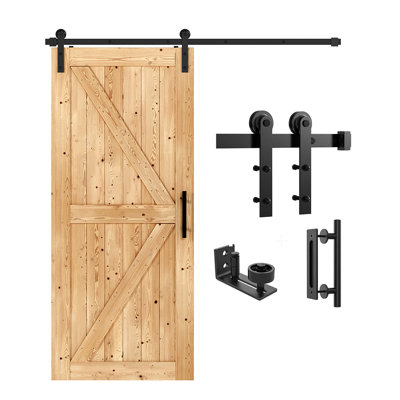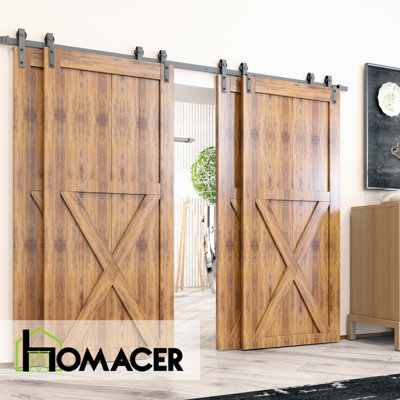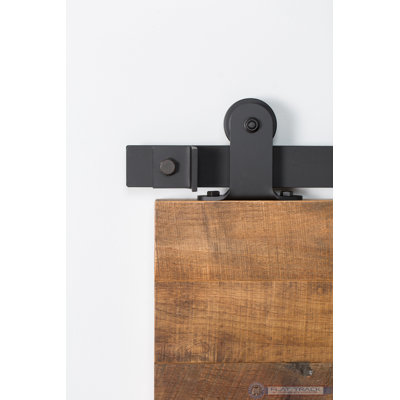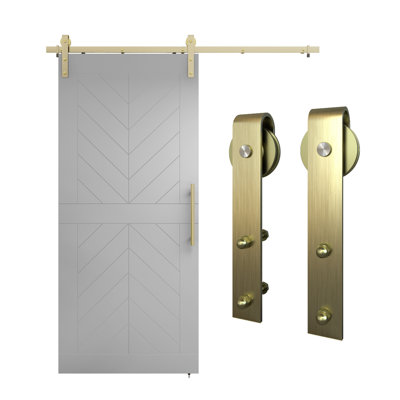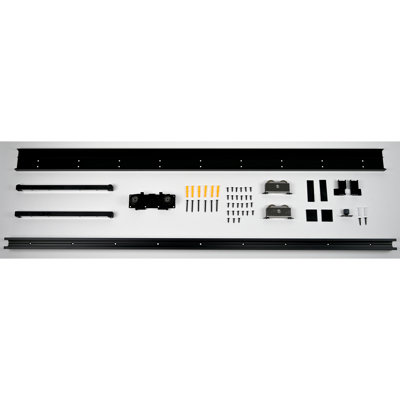The Patent pending Houdini Hardware™ features concealed rollers and rail, creating an uber-modern minimalist appearance. This system can be mounted and installed in 1 hour. All of the weight of the door is on the floor instead of hanging on the wall. Anodized black aluminum top rail and bottom door boot. Two soft-closing dampers. The wall-mounted Door Support Guide features an adjustment feature to raise the Guide to ensure a perfect fit between the Rollers and the Door Rail. Since the door rolls on the floor, this system is not compatible with most carpet. Only a tightly weaved carpet is compatible with this hardware.This hardware has been cycle-tested to 20,000 cycles.
The patented Houdini Hardware™ features concealed rails and rollers — this hardware is not visible on the wall, as it is mounted at the bottom edge and the back top edge of the door. Wheels mounted at the bottom of the rolling/sliding door roll directly on the floor, and carry 100% of the weight of the door. Since the door rolls on the floor, this system is not compatible with most carpet. Only a tightly weaved carpet is compatible with this hardware. A Door Support Guide is easily mounted on the wall, and is not visible even when the door is fully open or fully closed. An aluminum door track is mounted on the back of the door at the top edge. This Houdini Hardware requires doors that are 1-3/8” to 1-3/4” in thickness and no more than 48” wide with a weight of less than 175 pounds. Order two Houdini hardware kits for a double door installation. The Door Support Guide mounts on the wall at the top of the rolling door. Two rollers guide the door and keep it attached to the wall. The Door Support Guide is 5.9” wide and features a vertical adjustment knob and two safety anti-jump guides to keep the door secured to the wall. This Guide mounts to the wall with 6 fasteners. The Houdini Hardware also features 2 Soft-Close Dampers that will engage when opening and closing the door.
BEFORE INSTALLATION: Ensure your door slab is parallel with the wall. The wall mount from the kit may need to be shimmed to allow for equal spacing between the back of door and surface of wall in both open and closed positions
Door size depends upon the desired final appearance of the user. The Door Boot (which includes the wheels) may be mounted ON the bottom of the door or IN the bottom of the door The Wall Support may be mounted overlapping the opening making the door handle accessible on the back side of the door. Or the Wall Support Guide may be located aligned with or even spaced back from the edge of the door opening to allow the door to open to the full width or further than the wall opening. Refer to the online installation instructions for the Houdini Hardware for specific guidelines. And door size also depends upon if your wall opening is surrounded by decorative casing or molding. (Casing cannot be more than 1” deep).
Determine the minimum door width: Two options - either the door opens to with full width of the wall opening, or the door can partially cover a portion of the wall opening. (For instance - for a bathroom door, you may want 4 to 6 inches of door remaining accessible after opening to easily access the door pull from the bathroom side of the door).
To calculate door width to open exposing the full wall opening, then measure the distance of the wall opening and add 8” (wall opening width + 8” = minimum door width. The door can be wider than this). Example: If the wall opening is 30”, then a door size of at least 38” will be needed.
**NOTE** IF YOU HAVE CASING/TRIM AROUND THE OPENING, AND YOU WANT TO COVER WHEN FULLY OPEN OR FULLY CLOSED, PLEASE ACCOUNT FOR THE SIZE OF THE TRIM WHEN MEASURING FOR THE DOOR WIDTH. FOR EXAMPLE: The door opening is 30" and your trim on both sides adds 6", then a door size of 44" or larger will be needed for a FULLY OPEN APPLICATION.
For a Partially Open application, it is recommended that the width of the door is at least 8” greater than the width of the door opening. However, this application can be adjusted to a common width of the door. For example, if the wall opening is 30”, then a door size of at least 38” will be needed. A 36” wide door can be used by placing the edge of the door 2” into the opening. This will decrease the opening size from 30” to 28”.
Determine the minimum door height: For a Door Boot mounted ON (and not IN) the bottom edge of the door, measure between the finished floor and the top frame, then add 1” (height of the floor to the frame + 1” = minimum door height). IF your door opening has decorative casing, then measure from the floor to the top of the casing and add 1” for the minimum door height.
For a completely hidden and concealed hardware appearance, then mount the Door Boot INSIDE (and not ON) the bottom edge of the door. This requires routing an edge-to-edge slot in the bottom of the 1-3/4” thick door. To determine the door height for this installation, measure between the finished floor and the top frame, then add 3” (height of frame + 3” = minimum door height). IF your door opening has decorative casing, then measure from the floor to the top of the casing, and add 3” for the minimum door height.
Looks great - we have not installed yet, but happy with the speed of delivery and packaging. Will report back one week finish the room and install.. Anonymous. Thu Apr 24 2025
